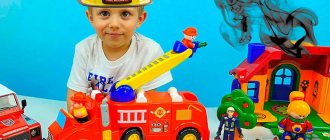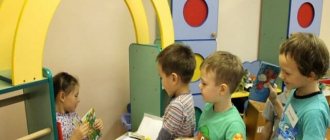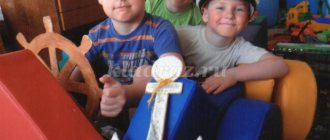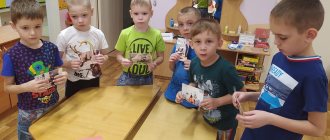MAGAZINE Preschooler.RF
Card index of games for the development of algorithmic skills in children 4-5 years old(middle group)
- Good bad
Goal: To form in children an idea of good and bad deeds, behavior, the ability to correctly evaluate themselves and others, develop algorithmic skills, and introduce them to the linear algorithm.
Rules of the game:
The game can be played collectively, in pairs or even by one child. Children need to look at the pictures; think about which of them illustrate good actions and which ones - bad; distribute the pictures into two groups “good” and “bad” , attaching them to the rays of emoticons.
Game actions:
Children look at the pictures, divide them into two groups “good” and “bad” , attaching them to the rays of emoticons.
Variety of game options:
- Children are asked to look at the pictures, determine what is good and what is bad, explain their decision, divide the pictures into two groups: good and bad , attaching them to the rays of emoticons.
- Children need to match each card on which a child behaves badly with a card on which a child behaves well in a similar situation.
- "Sticks in a Row"
Goal: to consolidate the ability to build a sequential series in size. Teach to act in a certain sequence.
Content. V. introduces the children to the new material and explains the task: “You need to line up the sticks in a row so that they decrease in length . Warns children that the task must be completed by eye (trying on and rearranging sticks is not allowed). “To complete the task, that’s right, each time you need to take the longest stick out of all those that are not laid in a row,” explains V.
- “Whoever walks correctly will find the toy”
Goal: to teach how to move in a given direction and count steps.
Content. The teacher explains the task: “We will learn to walk in the right direction and count steps. Let's play the game “Whoever walks correctly will find the toy . I hid the toys in advance. Now I will call you one by one and tell you in which direction you need to go and how many steps to take to find the toy. If you follow my command exactly, you will arrive correctly.” The teacher calls the child and suggests: “Take 6 steps forward, turn left, take 4 steps and find a toy . One child can be assigned to name a toy and describe its shape, all children can be tasked with naming an object of the same shape (the task is divided into parts), 5-6 children are called.
- Drawing up geometric shapes
Goal: to practice drawing geometric figures on the plane of the table, analyzing and examining them in a visually tangible way.
Material: counting sticks (15-20 pieces), 2 thick threads (length 25-30cm)
Tasks:
- Make a small square and triangle;
- Make small and large squares;
- Make a rectangle, the top and bottom sides of which will be equal to 3 sticks, and the left and right sides will be equal to 2;
- Make sequential figures from threads: circle and oval, triangles. Rectangles and quadrangles.
- Fun algorithm
The goal of the game is to develop logical thinking and also develop the ability to compose a linear algorithm.
Content. The child is offered cards depicting any algorithm (dressing, undressing, duty), he must arrange these cards in the correct order and build his own algorithm.
- “Build according to the algorithm”
*
The goal is to develop logical thinking and develop the ability to perform a linear algorithm.
Content. The child is given a card with a picture of an algorithm for building from cubes (Lego Duplo), the child must fold it step by step.
- "What's the beginning, what's next, Lego cubes"
The goal is to develop technical thinking and the ability to act according to a given linear algorithm.
Content. The child is offered cards, or Lego cubes, for example, with a fairy tale familiar to him, he must arrange it in the correct sequence of the plot.
- Interactive game “Write a fairy tale”
The goal is to develop mental processes in children, the ability to act strictly in a given algorithm.
Content. This game can be played individually, in a group or with a subgroup of children. Where the child chooses his own character, chooses the time of year, the house and the place where the fairy-tale character will live. After which, starting with the chosen character, he tells his tale.
- Guess where?
Goal: to develop the ability to determine spatial directions from oneself.
Material: toys or objects at the discretion of the teacher
Progress of the game: The teacher hides the toy, and the child must find it, following the teacher’s instructions, for example: “You need to find the toy. First take two steps forward, turn right, take three steps forward... etc.”
- Safety games (Cross the road correctly! Call the rescuers
The goal is to develop mental processes, develop mental abilities and visual perception; learn to correlate the speech form with a graphic image.
Content. In front of the child is a set of cards depicting the correct way to cross the road (actions in an emergency, algorithm for calling the police, medical assistance, rules for safe behavior on the road), the child must lay them out in the correct sequence.
Card index of games for the development of algorithmic skills in children 5-6 years old
Older age
- "Floor Algorithm"
The goal is to introduce children to the construction of the first movement algorithms and master the role of an assistant.
Contents.. The game has a playing field on which pictures are located and there is a set of cards with pictures that are used on the playing field. Option 1 on the algorithm - study the construction of the first movement algorithms. (robot child). The child takes on the role of a ROBOT and performs a sequence of his actions.
The second version of the game - the child takes any toy and, together with it, goes through the algorithm specified by the teacher. For example, a child needs to go from the image of a doll to the image of a car, the child goes in any direction forward, left, right, down, from point a to point b. When moving towards a goal, the child pronounces all the pictures that he encounters along the way.
These games can also be played by two people. One child builds a route, and the other child goes through it. In this game, the child masters the role of a helper.
- Maze games
The goal is to develop thinking and visual memory.
- Labyrinths using Dienesh Blocks
The goal is to introduce cyclic and branching algorithms.
Content. We lay out 8 logical blocks of Dienesh in front of the child and, while he does not see, under one of them we hide a “treasure” (coin, pebble, cut out picture, etc.). The child asks leading questions, but you can only answer “yes” or “no”: “Is the treasure under the blue block?” - “No” , “Under red?” - "No" . The child concludes that the treasure is under the yellow block and asks further about the size, shape and thickness. Then the child hides the “treasure”, and the adult asks leading questions.
- Game "entertaining algorithms"
The goal is to develop in children the ability to compose various algorithms. Learn to create a route algorithm.
Contents - The child needs to lay out in the table from the pictograms the program of the performer’s route according to the diagram. To complete the task, the child uses human figures.
- “Algorithms are interesting - helpers”
The game conditions correspond to the game “entertaining algorithms” .
- Game "decode the picture"
The goal is to teach children to read instructions and develop mental processes
Contents - The child needs to lay out a picture of colored squares on the playing field, according to the location encrypted in the card with the code.
- Game "matrix"
Goal – To teach children to read coded instructions, develop imagination, teach them to work in pairs, together.
Contents - A table containing the encoded information is given. The matrix contains information about the quantities, color and shape of parts needed for construction. While decoding the matrix, the child needs to correlate the information located in the columns and rows.
- Bee Bot robot games
The goal is to teach children structured activities that develop their imagination and offer plenty of opportunities to explore cause and effect relationships.
Content. Children give the logo-robot an action plan and also develop various tasks (adventures) for it.
| Next > |
Certificate No. 026/u for kindergarten: which doctors?
Table of contents
- Description
- Is it necessary
- Where to contact
- Analyzes
- About doctors
- List of documents
- Advantages of carrying out the procedure at MEDSI
The practice of maintaining unified medical records for each student goes back more than one decade. During this time, it demonstrated its advantages both for medical personnel and for parents, since if a child’s outpatient card was lost, it became possible to restore information using form No. 026/u-2000.
Description
A certificate for kindergarten is the first thing that modern parents of preschoolers face when they receive a ticket to a preschool educational institution.
Form No. 026/у-2000 is a child’s medical record, and not just a single certificate. This is a full-length A4 notebook with a thick cover, which will summarize all the medical information about the baby from the moment he enters kindergarten until the completion of secondary education.
General information is placed on the cover: last name, first name, patronymic of the minor, his gender, date of birth and registration address; below is the children's clinic to which he is assigned and contact phone numbers.
Is it necessary
The presence of a medical card No. 026/u-2000 for a kindergarten is mandatory, rather, for medical workers, since this is the main reporting document where information about the medical examinations performed, Mantoux reactions and vaccinations will be entered. On the other hand, maintaining a card is convenient for the parents themselves, as it allows them to obtain the necessary information from there (including in the form of extracts to be provided at the place of request), which can be especially important if the main outpatient card is lost.
Where to contact
In city clinics there is usually a rather long process of getting doctors and not always all the specialists are available. It is easier and more comfortable to conduct an examination of a preschooler in a private clinic, where all the necessary specialists are gathered in one place. Modern private clinics often offer comprehensive treatment.
Analyzes
In addition to the conclusions of specialists, a certificate for a child in kindergarten will contain laboratory tests.
- General urine analysis
- Clinical blood test + ESR
However, if a child has chronic diseases for which he is registered, this doctor will also be included in the list of specialists, and the list of tests may expand.
Like examination by specialists, obtaining test results can be expedited by contacting a private clinic. Here, the child will undergo all the examinations in one day, parents will be able to save working time, and the child will be able to minimize stress from medical interventions.
About doctors
Certificate for kindergarten form No. 026/у-2000 includes mandatory specialists, the list of which may vary slightly depending on the age at which the child first enters an educational institution. Some children skip kindergarten, and then parents apply for a child’s medical card (form No. 026/у-2000) only before first grade.
The child’s medical record for kindergarten will include:
- Examination and conclusion of a pediatrician
, with whom the medical examination will begin and with which it will end. In addition to the conclusion about the child’s readiness and ability to attend an educational institution, the pediatrician will issue referrals for tests, determine the health group and give recommendations regarding the characteristics or diseases identified as a result of the examination, if any. - The pediatric dentist
will not only assess the condition of the oral cavity, but will also make a conclusion about the correspondence of the number of teeth to the age of the preschooler in the form of a dental formula - The pediatric otolaryngologist
will check the level of hearing and evaluate the anatomical structure of the ENT organs - A pediatric neurologist
will assess the degree of psychological maturity and level of mental development - An orthopedic surgeon
or
pediatric surgeon
will evaluate the correct formation and development of the child’s musculoskeletal system and the functioning of the musculoskeletal system - A pediatric ophthalmologist
will check visual acuity - Children's gynecologist
examines girls - Pediatric urologist-andrologist
examines boys
A child’s medical development record for school will require a visit to the same specialists, in addition, it is necessary to undergo an examination by a psychiatrist
.
The following types of research are also carried out before school:
- Clinical blood test (+ ESR)
- General urine analysis
- ECG and echocardiography
- Ultrasound of the abdominal organs and kidneys
Children visit many of these specialists for routine examinations according to their age, however, some diseases may be first identified at a medical examination before admission to a preschool educational institution, since here the child receives a full comprehensive examination.
List of documents
To obtain a certificate for kindergarten No. 026/u you will need to have with you:
- Child's birth certificate
- SNILS (not required in private clinics)
- Insurance policy (in private clinics - only VHI policy)
- Passport of one of the parents, where the child is entered in the “Children” column (or passport of one of the guardians/adoptive parents)
- Vaccination certificate with vaccination marks
If the child does not have any vaccinations and the parents do not plan to vaccinate him before entering kindergarten/school, the medical office of the educational institution will require the parent to write a temporary refusal of vaccinations (Form No. 19n).
Advantages of carrying out the procedure at MEDSI:
- Availability of a comprehensive: the necessary specialists are brought together and completed in one day
- Tests can be taken on the day of treatment (and on the same day as specialists)
- Pediatric doctors with extensive experience and experience interacting with children: polite staff, technical service
To make an appointment, call 24/7: 8 (495) 7-800-500
Set for the game “Doctor”
The other day I noticed that our girls began to treat dolls, hares and bears. They come to eat with their “patients” and sit them next to each other on a chair to observe how they feel at this time. They feed sick dolls with a spoon and carefully wrap them in toy blankets. Then they go to the room and carefully look after the sick. After watching these games, I decided that the little ones clearly lack doctor’s tools and other medical “bells and whistles.” To begin with, we purchased the “Doctor” toy set, and then... my mother’s imagination ran wild!
For three days my daughters watched my serious preparations, asked questions and clapped their hands. And finally, they were given a big doctor's box. It contains medical instruments, boxes with medicines, forms for writing down prescriptions, badges with their names and all sorts of interesting and useful things. In addition, the surrounding play space turned into a doctor's office for them.
When I conceived the “Doctor” playset, I really wanted it to come out:
- Interesting and exciting so that you want to play with it again and again.
- Informative so that thanks to it the girls learn a little more about the profession of a doctor and the structure of the human body.
- Educational , so that the icons and inscriptions match and are large enough to read. And even though the girls can’t read yet, they know and recognize the letters. This way of presenting words stimulates reading, arouses interest in words and trains photographic memory.
- Compact because we don't have too much space to store it.
- Durable. This step is difficult to accomplish with paper, but possible.



